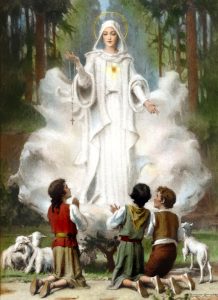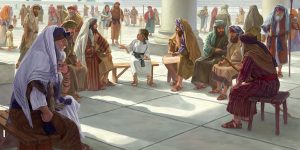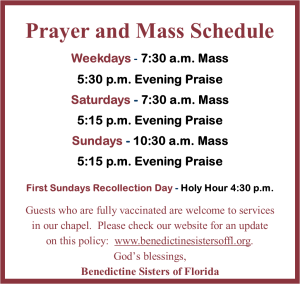 One of the lovely, but often misunderstood, elements of our Catholic religion is our devotion to Mary, the Mother of God. The Hail Mary is among the earliest prayers many of us learned, often from our mothers’ lips as our tired heads hit the pillow at night, or as the family gathered for the nightly recitation of the Family Rosary. Some of you may have grown up in the time close to the 50th anniversary (1967) of Mary’s appearance to the children at Fatima. There was a traveling statue that migrated from parish to parish. This practice was revived in 2017 during the 100th anniversary year.
One of the lovely, but often misunderstood, elements of our Catholic religion is our devotion to Mary, the Mother of God. The Hail Mary is among the earliest prayers many of us learned, often from our mothers’ lips as our tired heads hit the pillow at night, or as the family gathered for the nightly recitation of the Family Rosary. Some of you may have grown up in the time close to the 50th anniversary (1967) of Mary’s appearance to the children at Fatima. There was a traveling statue that migrated from parish to parish. This practice was revived in 2017 during the 100th anniversary year.
But, why talk about that today? It was the description in the Gospel of a good shepherd. You have heard that in ancient Israel, and even today particularly in South America, “good shepherds” are women. In my office hangs a picture of the La Divina Pastora (note the final letter connoting a feminine shepherd). Jesus says: “My sheep hear my voice; I know them.” Doesn’t that sound like a mother on alert for the cries of her child at all hours of the day or night? So, this being Mother’s Day weekend gives me an opening to reflect on devotion to Mary, Mother of our Savior. It’s a heart-connection: a non-threatening, “she-understands-me” sort of relationship. Stories of her miraculous appearances to people “just like us” fill us was with awe and a desire for closeness to Mary. [A Catholic calendar lists a different Marian commemoration for each day of the year.] We marvel at the believer’s relationship with Mary that naturally blends with their relationship with her Son, Jesus. We trust her instincts. We plead with her to “hold open the back door of heaven” for us. And (here at the monastery) we remind Mary each evening “never was it known that anyone who sought your intercession was left unaided.”
To borrow words of praise on Mary from S. Joan Chittister: “Mary is not simply “Mary, the Mother of God.” No, on the contrary. The Mother of God is the image of women everywhere. The Mother of God is Mary, independent woman; Mary, the unmarried mother; Mary, the homeless woman; Mary, the political refugee; Mary, the Third World woman; Mary, the mother of the condemned; Mary, the widow who outlives her child; Mary, the woman of our time who shares the divine plan of salvation; Mary, the bearer of Christ. Mary shows us the sanctifying power of a human being who has become fully human.” [Joan Chittister Women of Strength 2020]
It’s hard to explain in human words what a relationship with Mary means to me. I grew up in a parish where the pastor had GREAT devotion to our Lady. His voice softened when he spoke of her. He led his parishioners in a variety of devotional practices like May processions and crowning of statues, the living rosary in October and the practice of the Family Rosary. I’ve heard many converts to Catholicism say (in so many words) that it was through a loving relationship with Mary that they were encouraged to seek more information that eventually led them to enroll in an RCIA program … which led to their reception into the Church.
We echo the words of the angel’s greeting to Mary each time we pray the Hail Mary. Jesus’ cousin, John the Baptist, the unborn child in Elizabeth’s womb, is said to have recognized the presence of the Lord and leaped for joy. His mother Elizabeth is the “amazed saint” recognizing the unique blessedness of Mary. The attitude of Elizabeth is representative of the attitude we aim to emulate.
When Jesus was 12-years-old his parents, Mary and Joseph suffered the awful experience of losing a child. When they found him in the temple, “sitting among the teachers, listening to them and asking them questions” the only satisfaction they got from him was that he had to be about his Father’s business. Many have thought his words to be disrespectful but if you know 12-year-olds they sound pretty typical. At 12, every Jewish boy was expected to make his bar mitzvah and become a responsible subject of the law. Jesus says that he was never lost; he was at home; He was in his Father’s house.
they found him in the temple, “sitting among the teachers, listening to them and asking them questions” the only satisfaction they got from him was that he had to be about his Father’s business. Many have thought his words to be disrespectful but if you know 12-year-olds they sound pretty typical. At 12, every Jewish boy was expected to make his bar mitzvah and become a responsible subject of the law. Jesus says that he was never lost; he was at home; He was in his Father’s house.
The most puzzling part of the story, however, is the way it ends: “Then he went down with them and came to Nazareth, and was obedient to them”. The puzzle is this: If Jesus, already at the age of twelve, was ready to begin his public mission, and was evidently well prepared for it, why would he go down with his parents and spend the next eighteen years in the obscurity of a carpenter’s shed? He only began his public ministry at the age of thirty when the supply of wedding wine ran out. Mary jump-started his ministry with her directive to the servants – “Do whatever he tells you.”
When we reflect on the fact that for every one year of his public life Jesus spent ten years in family life, then we can begin to understand the importance and priority he gave to family life. And, now you may have a clue why I chose to speak of Mary on this Mother’s Day weekend. Maybe you, too, learned the simple prayer that begins: Lovely Lady, teach me how to pray; God was just your little boy, and you know the way.
~Reflection by Sister Roberta Bailey, OSB
Continue Reading

